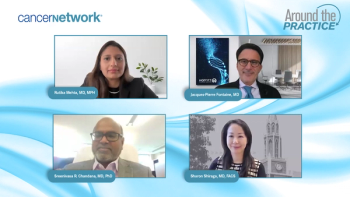
COCOON: Discussion of Clinical End Points and Dose Modifications
Panelists discuss how the COCOON dermatologic management protocol significantly reduced grade 2 or higher dermatologic adverse events in multiple locations, particularly on the face/body (23% vs 62%), scalp (9% vs 29%), and nails (16% vs 21%).
Episodes in this series

Video content above is prompted by the following:
Dermatologic Adverse Events—COCOON vs Standard of Care
Study Focus:
This study assessed the impact of the COCOON dermatologic management intervention vs standard of care in reducing dermatologic adverse events (DAEs) during oncology treatment.
Primary End Point:
- Grade 2 or higher dermatologic adverse events within the first 12 weeks
Key Findings:
- Grade 2 or higher DAEs:
- COCOON: 38%
- Standard of care: 76%
- Half the rate of significant skin toxicities with COCOON
- Grade 3 DAEs:
- COCOON: 4.3%
- Standard of care: 8.8%
- Severe cases were also notably reduced.
- Statistical significance:
- OR: 0.19—a highly significant finding, rarely seen in oncology
DAEs by Location:
- Face/body: 23% (COCOON) vs 62% (standard of care)
- Scalp: 9% vs 29%—noted as particularly difficult to manage because of the risk of infection and scabbing
- Paronychia: 16% vs 21%—bothersome, especially in dry weather, but generally manageable
Clinical Impact:
- The COCOON intervention not only reduced the severity and frequency of DAEs but also helped patients:
- Stay on treatment longer
- Avoid dose interruptions and reductions
Treatment Tolerability:
- Dose interruptions: 16% (COCOON) vs 34% (standard of care)
- Dose reductions: 7% (COCOON) vs 19% (standard of care)
- Discontinuations: 1 patient (COCOON) vs 3 patients (standard of care)
Conclusion:
The COCOON intervention significantly reduces dermatologic toxicities, improves patient quality of life, and allows for better adherence to cancer therapy within the critical first 12 weeks, and likely beyond.
Newsletter
Stay up to date on recent advances in the multidisciplinary approach to cancer.














































































